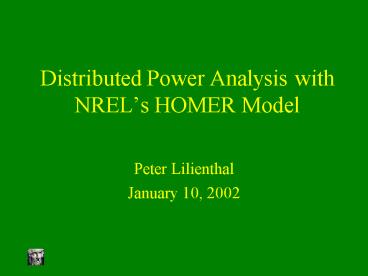Distributed Power Analysis with NRELs HOMER Model PowerPoint PPT Presentation
1 / 31
Title: Distributed Power Analysis with NRELs HOMER Model
1
Distributed Power Analysis with NRELs HOMER Model
- Peter Lilienthal
- January 10, 2002
2
Outline
- What is HOMER
- History
- Off-grid
- Grid Connected
- Short Demo
- Sample Results
3
What is HOMER?
HOMER is a computer model for designing small
electric power systems.
- Electrification of remote villages
- Off-grid houses
- Dedicated Applications
- telecom sites, water pumping
- Distributed generation (grid-connected)
- green power
- cogeneration (combined heat and power)
4
Economic optimization for least-cost design
- Compete technologies - consistent approach
- 8760 hour simulations
- renewable resource variability
- Extensive sensitivity analysis
- Graphical outputs
5
HOMERs capabilities
HOMER can model any combination of
- Wind turbines
- PV
- Small hydro (run-of-river)
- Generator (fossil fuel or biomass)
- Battery storage
- Grid extension or support
6
Hybrid Optimization Model for Electric Renewables
- Developed by NRELs Village Power Program in 1993
- Major redesign in 1997 to make it accessible to
general public - Has become an international standard for off-grid
power design and analysis - 1300 users in 110 countries
7
Current Status
- 100 funds-in CRADA with ESKOM (South Africa) to
incorporate into their GIS - Training in Argentina, Philippines Australia
- DDRD for grid-connected DG analysis
- Simplified web interface in beta testing
- Collaborate with 7 NREL center/offices
8
Enhancements for Grid-connected DG
- Tariff module
- Cogeneration
- Additional Technologies
- Modular and decentralized
- RETs competition
- Micro-turbines
- Fuel cells
9
Current Accomplishments
- New technologies have been added
- Biomass, micro-hydro
- Multiple fuel capability
- More flexible generator module that can handle
micro-turbines and fuel cells - More kinds of hybrids
- Thermal loads for cogeneration
- Simplified Rate structure
- Retail, buyback demand
- Carbon Tax
10
Proposed Work
- Rates
- Standby/backup rates
- Time-of-use and seasonal pricing
- Net metering
- Hourly pricing
- Ratchet clauses
- Block pricing???
- Facilitate comparing stand-alone and grid-connect
- Create beta version
- Case studies verify parameters
- Documentation
11
Main window
12
Main window
There are 4 types of inputs.
13
Inputs electric load
Multiple types of loads, can vary monthly.
14
Inputs wind resource
Data can be entered from a file or generated.
15
Inputs wind turbine
Each component requires simple cost and
performance data.
16
Inputs optimization
The user has to tell HOMER what types of systems
to consider.
17
Outputs
HOMER rank orders the solutions by Net Present
Value
18
Outputs
HOMER also categorizes them.
19
Sensitivity analysis
Useful for uncertain parameters technology,
market and policy analysis.
20
Sensitivity analysis
Which technology is best at different wind speeds
or fuel prices.
21
Village power system
How does the cost of energy change?
22
Village power system
How does the fuel use vary?
23
Market Impact of Carbon Tax
24
Market Impact of Tax Credits
25
Hybrid Design
26
Engine Competition
27
Explanation of Counter-intuitive Result
The less efficient technology is chosen at higher
fuel prices because it is only used for peak
shaving.
28
Cogeneration
29
HOMER Online
Very simplified interface.
30
HOMER Online
All of the outputs are still available.
31
Contact information
- Main website
- www.nrel.gov/international/homer/
- HOMER Online
- analysis.nrel.gov/homer
- Questions
- peter_lilienthal_at_nrel.gov

